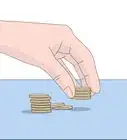wikiHow is a “wiki,” similar to Wikipedia, which means that many of our articles are co-written by multiple authors. To create this article, 16 people, some anonymous, worked to edit and improve it over time.
wikiHow marks an article as reader-approved once it receives enough positive feedback. In this case, 90% of readers who voted found the article helpful, earning it our reader-approved status.
This article has been viewed 218,203 times.
Learn more...
Contract bridge, more commonly just called bridge, is a card game for four players that can be played at any level from casual get-togethers to professional tournaments. Bridge's popularity has waxed and waned in the decades since its creation, but it remains one of the most popular four player card games in the world. Read the steps below to learn the basics of this deep and engaging game.
Steps
Basic Elements
-
1Find three friendly co-players. Bridge is a four-player game played in teams of two players each, so your significant other and another couple are a good potential choice. Teams sit across from each other around a square table.[1]
- For purposes of notation, each side of the table is given the name of a cardinal direction. Thus, the players in a bridge game are commonly referred to as North, South, East, and West. North and South play on a team against East and West.[2]
-
2Learn the structure of the game. Bridge is played with a standard 52-card deck in deals of 13 cards per player, so that the entire deck is dealt out each hand. After the deck is dealt, players make bids. The final bid determines the importance of each suit as well as the overall goal for each deal. Deals are then played card-by-card in 13 sub-rounds known as “tricks.” The goal of the game is to win 7 or more tricks on each deal in order to score points. Deals continue until one team accumulates a predetermined number of points.
- Scoring systems vary from style to style and group to group.
- Players typically take turns in a clockwise fashion. This means that actions alternate evenly between the two teams.
Steps of the Game
-
1Deal the cards. The dealer distributes 13 cards to each player, so that the entire deck is used. Give players time to sort their cards by rank and suit. Aces are high in bridge, followed by kings, queens, jacks/knaves, tens, and finally spot (number) cards from 9 to 2.[3]
- The more cards in a suit you have, and the higher the value of those cards, the better luck you are likely to have with them. Keep this in mind as bidding begins.
-
2Make bids and award the contract. Teams bid numbers and suits, which represent the number of tricks they believe they can win on the deal if the suit attached to that number becomes the trump suit (the suit of cards that will be more valuable than the other 3 suits during tricks). Whoever deals will get to bid first, and bidding rotates clockwise from the dealer around the table, continuing for as many rounds as is necessary to settle on a final bid. Whichever team ends up bidding the highest number wins the right to name the trump suit. There are many rules and special terms governing the bidding phase; this guide will cover the basics required to play a friendly game.[4]
- A minimum of 7 tricks are required to win each deal. (This is because there are 13 tricks per deal, and a majority must be won to win the deal.) Bridge players therefore traditionally count bids starting from the seventh trick, referring to the first 6 tricks collectively as “the book.” If your team wants to bid 7 tricks (saying that you expect to win 7 of the 13 tricks for the current deal), you would announce a bid of 1, and so on up to a bid of 7 for winning all 13 tricks.
- You can remember this easily by adding 6 to whatever number is bid to get the actual number of tricks that must be won to “make” (complete) the contract. You can't ever bid to win less than 7 tricks (a bid of 1).
- Suits are important during bidding. The power of the suit you bid will determine how many other cards will be able to outbid it. The suits are ranked from most powerful to least powerful as follows: spades, then hearts (these are known as the “major” suits), then diamonds, and finally clubs (the “minor” suits).
- Each new bid must be more “valuable” than the last bid before it, so if the person before you bid 1 in hearts, you must either bid 1 in spades or 2 (or more) in any other suit to beat it.
- It is often advisable to bid on the most common suit in your hand, even if it is relatively weak. For example, if your hand has six cards with the diamond suit, you might lean towards bidding for diamonds to become the trump suit. Pay attention to the bids your partner makes to get an idea of what he or she is holding as well.
- No trump bids: In addition to bidding for a trump suit, you can declare a bid of “no trump” (sometimes condensed as “notrump,” and abbreviated NT), which indicates you are only bidding a number, not a suit. If you win a no trump bid, tricks are played without a trump suit, meaning only the highest ranked card in each trick can win it. This is riskier than naming a trump suit, but making (completing) a no trump contract will score your team more points than a regular contract.
- For bidding purposes, NT is considered the highest “suit;” therefore, the highest possible bid is 7NT.
- Beware of overreaching on your bid. If your team wins a bid and is subsequently unable to make that number of tricks by the end of the deal, you must pay the opposing team a number of points from your own total, which can quickly change the balance of power.
- You do not have to bid. You can pass a bid to the next person instead. If three players pass in a row, the last bid wins the contract and determines the trump suit; if all four players pass without any bids at all, the deck is reshuffled and the hands dealt out a second time.
- There are special terms for each player once a contract has been awarded. The person who made the winning bid is called the “declarer,” and his partner is called the “dummy.” The other team are collectively calle the “defenders.” Knowing these terms makes it easier to keep track of the flow of the game.[5]
- A minimum of 7 tricks are required to win each deal. (This is because there are 13 tricks per deal, and a majority must be won to win the deal.) Bridge players therefore traditionally count bids starting from the seventh trick, referring to the first 6 tricks collectively as “the book.” If your team wants to bid 7 tricks (saying that you expect to win 7 of the 13 tricks for the current deal), you would announce a bid of 1, and so on up to a bid of 7 for winning all 13 tricks.
-
3Begin the first trick. Now that a trump suit (or a bid of no trump) has been established for the deal, the tricks begin. Play begins with the defender to the left of the declarer. The defender “leads” the trick by placing a card face up on the table. The suit of this card is the suit for the trick, which means that players can only win the trick with a card of that suit, or a trump suit card.
- The other two suits don't count during this trick.
- Once the trick has been led, the dummy spreads his or her entire hand out on the table, usually in four columns organized by suit. The dummy's hand is played by the declarer for the rest of the deal. Defenders play normally.
- The dummy has an unusual role. The dummy cannot comment on the strategic decisions of the declarer, but is allowed to point out when the declarer would accidentally violate a rule of the game. Otherwise, he or she leaves the decisions to the declarer for the duration of the deal.[6]
- Lead suit cards must be played if possible. For example, if the suit of the lead card is clubs, and you have a club in your hand, you must play it rather than any other card. If you don't have any cards in the leading suit, you may “ruff” (play a trump suit card, assuming it is different from the lead suit) or “sluff” (play a card from one of the two remaining suits).
- A ruff is likely to win the trick, as any card from a trump suit beats every card of every other suit.
- A sluff is functionally the same as a pass, and cannot ever win the trick.
-
4Finish the trick and start the next one. After the opening lead, the declarer plays a card from the dummy's hand. The second defender plays a card after that, and finally the declarer plays a card. Once all four cards have been played, the most valuable card wins the trick, and whoever played that card keeps all four cards in the trick for scoring later.
- Whoever wins a trick leads the next trick. There is no set leading pattern after the first trick.
-
5End the deal. When all 13 tricks have been played, add up the number of tricks each team won. If the declaring team made the contract, they win the deal; otherwise, the defending team wins the deal. Award points based on your chosen system. Extra points should be awarded for making a no trump contract.
-
6Start the next deal. Put the cards back together in a deck and deal out 13 cards to each player once more. This is the second deal. Deals continue in the pattern outlined above until one team earns enough points to win the game.
- To play a relatively quick game, play until one team has won a specified number of deals (for instance, 2 out of 3) instead of counting points.
Strategy
-
1Play often. There is always more to learn about bridge strategy. The best way to improve your game is to practice by playing a lot. Books and guides can help a lot, but at the end of the day, developing a sense of when to do what is a matter of gaining experience with the game.
-
2Learn to read your partner. You can't directly communicate with your partner during bidding, but there are ways for you and your partner to send each other cues about what each of you would like out of a contract. The opening round of bids is often used to tell your partner what your strongest suit is, rather than actually make a serious bid.[7]
- Your partner can support your bid by bidding a higher number in the same suit as your bid (signaling that he or she is also happy with the suit), or suggest a different approach by bidding a different suit.
- No trump bids often indicate that a person has a hand full of face cards and aces that are likely to win a lot of tricks based solely on rank.
-
3Try card scoring to determine hand strength. If you're having trouble estimating the strength of your hand, there is a commonly used way to score the cards in your hand in order to assess it more accurately. In this system, the deck has a total of 40 points.
- The points are assigned as follows:
- Aces are worth 4 points.
- Kings are worth 3 points.
- Queens are worth 2 points.
- Jacks/knaves are worth 1 point.
- If your hand has 12 or 13 points or more, it is probably a very strong hand.
- With practice, this system can help you decide where to place your opening bids to guide the final bid to an advantageous result.
- The points are assigned as follows:
-
4Keep your strategy simple at first. Two of the four cardinal ways to win a trick are easy enough to understand that you can adopt them into your strategy right away. (The other two methods are more complicated, and rely on indirectly controlling the way your opponents play their hands by keeping track of the cards they have already played and are likely to play in the future.) By anticipating which of these two techniques to use at what time, you can improve your chances of making the contract (or successfully defending against it). The two methods are:
- Playing the highest card in the trick.
- Beating an opponent's high card with a trump card.
-
5Work with your dummy's hand to make contracts. When you lead a trick as the declarer, if you and your dummy control the highest cards in the trump suit between your two hands, you can be sure that each trick leading from that suit will be yours. These are called sure tricks, and they are a good simple way to up your trick count. Lead with a card in your sure suit, and then play the next highest card from the dummy's hand to lock in the victory.
- Since you won the trick, you will lead the next trick as well. Repeat the pattern until you have played out all your sure tricks.
- Remember, you only need to make your contract to win the deal. Get as many sure tricks as you can to easily boost your total.
Community Q&A
-
QuestionDo I have to cut the cards before dealing?
 Community AnswerYes, the player to the right of the dealer must cut a minimum of four cards.
Community AnswerYes, the player to the right of the dealer must cut a minimum of four cards. -
QuestionWhat will happen if a player does not follow suit despite having one in their hand?
 Community AnswerIt is called a revoke and there is a penalty assessed if noticed by another player. The penalty varies depending on whether you a playing house rules or the American Contract Bridge League rules.
Community AnswerIt is called a revoke and there is a penalty assessed if noticed by another player. The penalty varies depending on whether you a playing house rules or the American Contract Bridge League rules. -
QuestionIs there a time limit between tricks?
 Community AnswerNo. There is a hand time limit of 7 minutes per hand. If only one of the pairs is delaying, you can call the director if playing duplicate. In social bridge, however, just ask the person to hurry up!
Community AnswerNo. There is a hand time limit of 7 minutes per hand. If only one of the pairs is delaying, you can call the director if playing duplicate. In social bridge, however, just ask the person to hurry up!
wikiHow Video: How to Play Bridge
References
- ↑ https://www.acbl.org/learn_page/how-to-play-bridge/
- ↑ http://www.bridgebum.com/how_to_play_contract_bridge.php
- ↑ https://www.funbridge.com/how-to-play-bridge
- ↑ https://www.acbl.org/learn_page/how-to-play-bridge/
- ↑ https://www.acbl.org/learn_page/bridge-terminology/
- ↑ https://www.funbridge.com/how-to-play-bridge
- ↑ https://www.larryco.com/bridge-articles/21-rules-of-being-a-good-partner
About This Article
Bridge is a card game played by 4 players split into 2 teams. The goal of the game is to take as many tricks, or sets of 4 cards, as possible, until one team scores 100 points. Scores are tallied beneath a horizontal bar on a cross-shaped scorecard, so scoring points is called scoring “below the line." Two games must be won in order to finish a match, called a “rubber.” All points are calculated at the end of the match to determine the overall winner. To begin each round, teammates sit across from one another, and the dealer distributes 13 cards to each player. Players then arrange their cards in ascending or descending order by suit. Then, starting with the player to the left of the dealer, players take turns bidding on the number of tricks that they think their team will win. Bidding starts automatically at 6 tricks, so a bid of “1” means that the bidding player thinks their team will take 7 tricks in a round. In addition to the number of tricks, the bidding player must declare a suit to be the trump suit for the round, so a bid of “3 spades” means that the bidding team must win 9 tricks to win the round and that spades will be the highest suit. Each player at the table takes turns bidding, going clockwise. When bidding, each consecutive bid must be higher than the previous bid in either number or suit. The order of the suits, from lowest to highest, are clubs, diamonds, hearts, spades, and no trump. No trump means that spades, diamonds, hearts, and clubs are all equal and no single suit trumps another. Players can also bid “double,” which means that the previous bid will be worth twice as many points, or “redouble,” which means the previous bid will be worth 4 times as many points. Bids of double or redouble are ignored if another player bids afterwards. You can also say “pass,” to skip your bid. Once 3 consecutive players have passed, bidding is closed. The last player to make a legal bid before 3 passes occur becomes the winning bidder. The team that loses the bid becomes the defending team, and cannot score below the line in that round. The player to the left of the player that won the bid plays their first card. Then, the winning bidder’s partner lays their cards face up on the table and becomes the “dummy,” which means they are not playing for the round. The player that won the bid selects a card from the dummy’s hand, and players take alternating turns playing 1 card from their hand until every player has played a card. The winner of a trick is the player that played the highest card in the suit, or the highest trump card. Players must follow the opening suit unless they no longer have a card in the suit being played. The trump suit is higher than the other suits at the table, so on a bid of 1 spade, the 2 of spades would trump any heart, diamond or club, and can only be beat by playing a higher spade. The winning player in a round collects the trick and places it face-down in a pile in front of them before starting the next trick. At the end of the round, each team counts the number of tricks they’ve won to determine the score. Scoring is modified based on the winning bid. If the winning bid was in hearts or spades, each trick is worth 30 points. If the winning bid is in diamonds or clubs, each trick is worth 20 points. The first trick in no trump is worth 40 points, and every additional trick is worth 30 points. You do not get points for the first 6 tricks that you win. So if a team bids 4 hearts and successfully takes 10 tricks, they are awarded 120 points, since they get 30 points each for the 4 tricks. Points awarded for successfully reaching your opening bid are scored below the horizontal line on your scoresheet. If a team wins more tricks than they bid, any additional trick is scored above the line with the same point values. Once a team scores 100 points below the line, they win the game and an additional line is drawn underneath it to indicate that a new game is starting. Each team’s score below the line resets at 0. When a team has won a game, they are “vulnerable,” which means that the penalty for failing to reach the contract bid is doubled. When a team fails to reach the contract bid, they are penalized 50 points for each trick under the contract if they’re not vulnerable, and 100 points for each trick if they’re vulnerable. These points are scored above the line. All point values are doubled or multiplied by 4 if a bid was doubled or redoubled before the bidding closed. When 2 games are won below the line and a team completes the rubber, the winning team is awarded 500 points above the line. Then, points above and below the line are added together to determine each team’s final score. The winning team is the team with the most points. If you want to learn strategies on how to win bridge, keep reading the article!
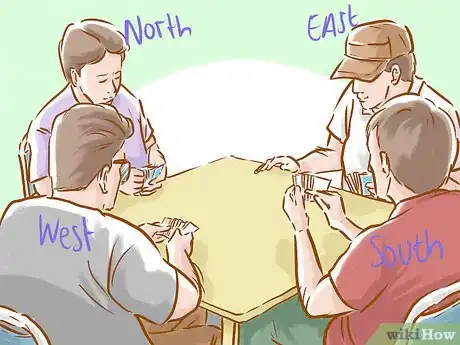
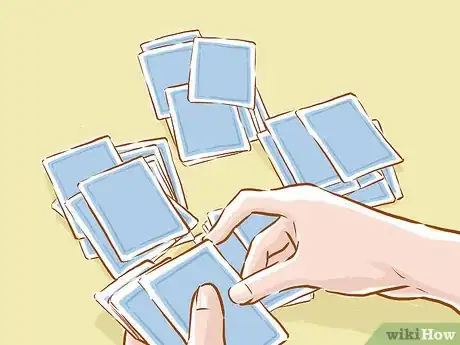
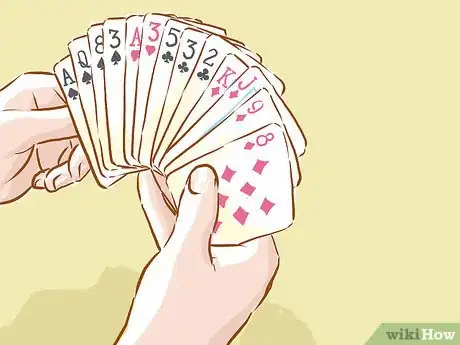

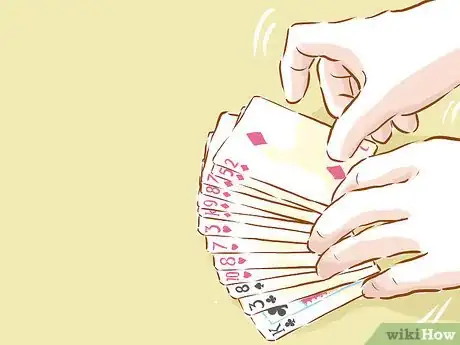
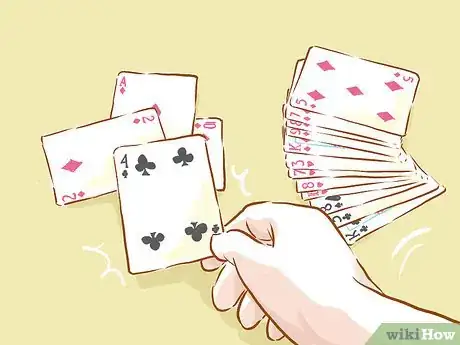
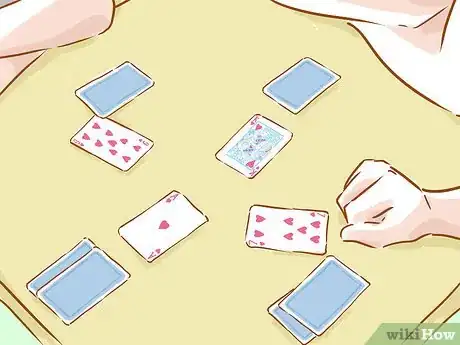
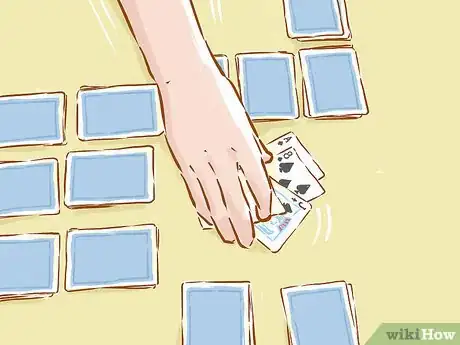


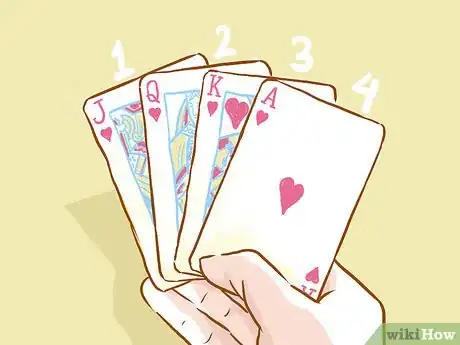
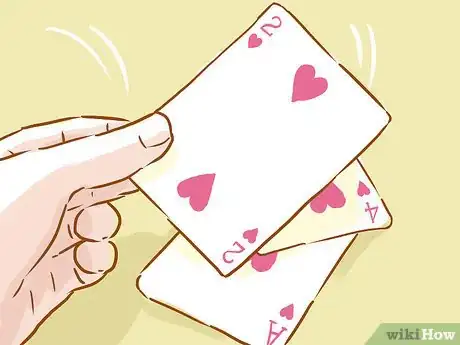


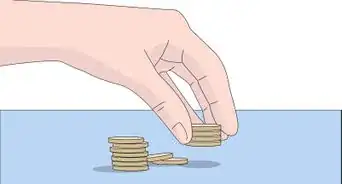
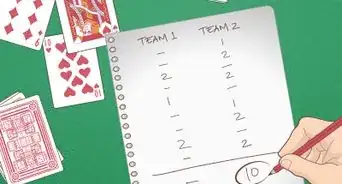
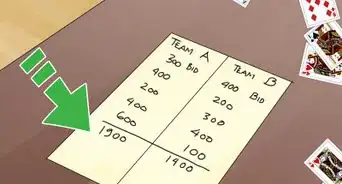


-Step-7-Version-2.webp)
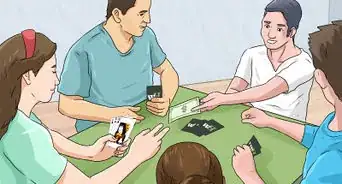

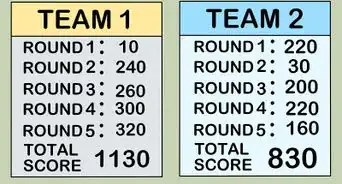
-Step-9-Version-2.webp)









